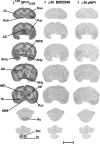BIIE0246, a potent and highly selective non-peptide neuropeptide Y Y(2) receptor antagonist
- PMID: 10725255
- PMCID: PMC1571943
- DOI: 10.1038/sj.bjp.0703162
BIIE0246, a potent and highly selective non-peptide neuropeptide Y Y(2) receptor antagonist
Abstract
1. BIIE0246, a newly synthesized non-peptide neuropeptide Y (NPY) Y(2) receptor antagonist, was able to compete with high affinity (8 to 15 nM) for specific [(125)I]PYY(3 - 36) binding sites in HEK293 cells transfected with the rat Y(2) receptor cDNA, and in rat brain and human frontal cortex membrane homogenates. 2. Interestingly, in rat brain homogenates while NPY, C2-NPY and PYY(3 - 36) inhibited all specific [(125)I]PYY(3 - 36) labelling, BIIE0246 failed to compete for all specific binding suggesting that [(125)I]PYY(3 - 36) recognized, in addition to the Y(2) subtype, another population of specific NPY binding sites, most likely the Y(5) receptor. 3. Quantitative receptor autoradiographic data confirmed the presence of [(125)I]PYY(3 - 36)/BIIE0246-sensitive (Y(2)) and-insensitive (Y(5)) binding sites in the rat brain as well as in the marmoset monkey and human hippocampal formation. 4. In the rat vas deferens and dog saphenous vein (two prototypical Y(2) bioassays), BIIE0246 induced parallel shifts to the right of NPY concentration-response curves with pA(2) values of 8.1 and 8.6, respectively. In the rat colon (a Y(2)/Y(4) bioassay), BIIE0246 (1 microM) completely blocked the contraction induced by PYY(3 - 36), but not that of [Leu(31), Pro(34)]NPY (a Y(1), Y(4) and Y(5) agonist) and hPP (a Y(4) and Y(5) agonist). Additionally, BIIE0246 failed to alter the contractile effects of NPY in prototypical Y(1) in vitro bioassays. 5. Taken together, these results demonstrate that BIIE0246 is a highly potent, high affinity antagonist selective for the Y(2) receptor subtype. It should prove most useful to establish further the functional role of the Y(2) receptor in the organism.
Figures








Similar articles
-
Blockade of neuropeptide Y(2) receptors and suppression of NPY's anti-epileptic actions in the rat hippocampal slice by BIIE0246.Br J Pharmacol. 2002 Jun;136(4):502-9. doi: 10.1038/sj.bjp.0704751. Br J Pharmacol. 2002. PMID: 12055128 Free PMC article.
-
Vascular pharmacology of BIIE0246, the first selective non-peptide neuropeptide Y Y(2) receptor antagonist, in vivo.Br J Pharmacol. 2001 Aug;133(7):1073-80. doi: 10.1038/sj.bjp.0704171. Br J Pharmacol. 2001. PMID: 11487518 Free PMC article.
-
Functional consequences of neuropeptide Y Y 2 receptor knockout and Y2 antagonism in mouse and human colonic tissues.Br J Pharmacol. 2003 Jun;139(4):863-71. doi: 10.1038/sj.bjp.0705298. Br J Pharmacol. 2003. PMID: 12813010 Free PMC article.
-
Apparent affinity and potency of BIBP3226, a non-peptide neuropeptide Y receptor antagonist, on purported neuropeptide Y Y1, Y2 and Y3 receptors.Eur J Pharmacol. 1995 May 4;278(1):R3-5. doi: 10.1016/0014-2999(95)00179-o. Eur J Pharmacol. 1995. PMID: 7664808 Review.
-
Bioassays for NPY receptors: old and new.Regul Pept. 1998 Sep 25;75-76:79-87. doi: 10.1016/s0167-0115(98)00055-x. Regul Pept. 1998. PMID: 9802396 Review.
Cited by
-
Intracolonic Neuropeptide Y Y1 Receptor Inhibition Attenuates Intestinal Inflammation in Murine Colitis and Cytokine Release in IBD Biopsies.Inflamm Bowel Dis. 2022 Mar 30;28(4):502-513. doi: 10.1093/ibd/izab243. Inflamm Bowel Dis. 2022. PMID: 34613372 Free PMC article.
-
Nonconventional glucagon and GLP-1 receptor agonist and antagonist interplay at the GLP-1 receptor revealed in high-throughput FRET assays for cAMP.J Biol Chem. 2019 Mar 8;294(10):3514-3531. doi: 10.1074/jbc.RA118.005682. Epub 2019 Jan 8. J Biol Chem. 2019. PMID: 30622136 Free PMC article.
-
Emotional behavior in aged neuropeptide Y (NPY) Y2 knockout mice.J Mol Neurosci. 2006;28(3):239-45. doi: 10.1385/JMN:28:3:239. J Mol Neurosci. 2006. PMID: 16691011
-
The cardiac sympathetic co-transmitter galanin reduces acetylcholine release and vagal bradycardia: implications for neural control of cardiac excitability.J Mol Cell Cardiol. 2012 Mar;52(3):667-76. doi: 10.1016/j.yjmcc.2011.11.016. Epub 2011 Dec 7. J Mol Cell Cardiol. 2012. PMID: 22172449 Free PMC article.
-
Blockade of neuropeptide Y(2) receptors and suppression of NPY's anti-epileptic actions in the rat hippocampal slice by BIIE0246.Br J Pharmacol. 2002 Jun;136(4):502-9. doi: 10.1038/sj.bjp.0704751. Br J Pharmacol. 2002. PMID: 12055128 Free PMC article.
References
-
- BARRACO R.A., ERGENE E., DUNBAR J.C., EL-RIDI M.R. Cardiorespiratory response patterns elicited by microinjections of neuropeptide Y in the nucleus tractus solitarius. Brain Res. Bull. 1990;24:465–485. - PubMed
-
- BERGDAHL A., NILSSON T., CATERA L., NILSSON L., SUN X.Y., HEDNER T., ERLINGE D., VALDEMARSON S., EDVINSSON D. Neuropeptide Y potentiates noradrenaline-induced contraction through the neuropeptide Y Y1 receptor. Eur. J. Pharmacol. 1996;316:59–64. - PubMed
-
- BITRAN M., DANIELS A.J., BORIC M.P. GW1229, a novel neuropeptide Y Y1 receptor antagonist, inhibits the vasoconstrictor effect on neuropeptide Y in the hamster microcirculation. Eur. J. Pharmacol. 1997;319:43–47. - PubMed
-
- BLOMQVIST A.G., HERZOG H. Y-receptor subtypes–how many more. Trends Neurosci. 1997;20:294–298. - PubMed
Publication types
MeSH terms
Substances
LinkOut - more resources
Full Text Sources
Other Literature Sources
Molecular Biology Databases
Research Materials
Miscellaneous

